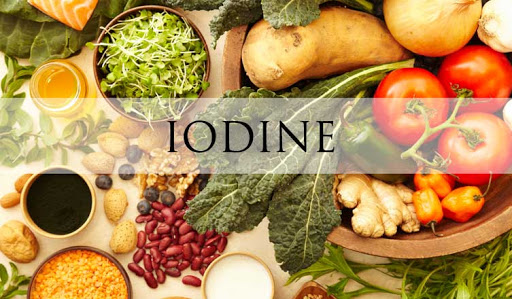Articles

Iodine
Iodine is a trace
element essential to the human body. It is needed in small amounts and can be
obtained naturally from food or through supplements.
Uses of Iodine
The body uses iodine
to produce thyroid hormones (thyroxine – T4 and triiodothyronine – T3),
which are responsible for:
- Regulating the rate at which calories are
burned (metabolism)
- Speeding up or slowing down heart rate
- Regulating body temperature
- Influencing gastrointestinal motility (how
fast food moves through the digestive system)
- Controlling muscle contraction
- Managing the replacement of dead cells
with new ones
During pregnancy
and lactation, iodine is
especially important for:
- Supporting mental and neurological
development in the fetus
- Regulating fetal metabolism
- Supporting proper growth in children
Daily Iodine
Requirements
|
Age Group |
Males |
Females |
Pregnant Women |
Breastfeeding
Women |
|
0–6 months |
110 mcg |
110 mcg |
— |
— |
|
7–12 months |
130 mcg |
130 mcg |
— |
— |
|
1–8 years |
90 mcg |
90 mcg |
— |
— |
|
9–13 years |
120 mcg |
120 mcg |
— |
— |
|
14+ years |
150 mcg |
150 mcg |
220 mcg |
290 mcg |
Major Food Sources
of Iodine
|
Group |
Examples |
|
Proteins |
Seafood, chicken,
eggs, beans, soybeans, meats, cottage cheese |
|
Dairy |
Milk, yogurt |
|
Fruits &
Vegetables |
Corn, green peas,
dried plums (prunes) |
|
Carbohydrates |
Rice, pasta, bread,
oats, iodine-fortified flour |
|
Other Sources |
Iodized salt |
Iodine Deficiency
Symptoms of iodine
deficiency may include:
- In pregnant women: impaired
physical and mental development in the fetus
- Goiter (thyroid gland swelling) and
hypothyroidism
- Unexplained weight gain
- Fatigue and weakness
- Hair loss
- Feeling unusually cold
- Irregular heart rate
- Irregular menstrual cycles
- Difficulty with learning and memory
People at higher
risk:
- Pregnant women
- Those consuming high amounts of
goitrogenic foods (e.g., broccoli, cabbage, spinach)
- People who use non-iodized salt
- Individuals following a strict vegan diet
Iodine Toxicity
Consuming iodine beyond
the upper intake limit—typically from supplements—can lead to:
- Hyperthyroidism
- Unexplained weight loss
- Elevated body temperature
- Irregular heartbeat
- Burning sensation in the mouth and throat
- Diarrhea
Upper Tolerable
Limits for Iodine Intake
|
Age Group |
Upper Limit |
|
0–12 months |
Unknown |
|
1–3 years |
200 mcg |
|
4–8 years |
300 mcg |
|
9–13 years |
600 mcg |
|
14–18 years |
900 mcg |
|
19+ years |
1000 mcg |
Interaction with
Medications
Iodine from
supplements may interact with:
- Hyperthyroidism medications
- High blood pressure medications
- Potassium-sparing diuretics
- www.ods.od.nih.gov/factsheets/Iodine-Consumer/
- Ershow, A.G.; Skeaff, S.A.; Merkel, J.M.; Pehrsson, P.R. Development of Databases on Iodine in Foods and Dietary Supplements. Nutrients2018, 10, 100
- Pehrsson, P. R., Patterson, K. Y., Spungen, J. H., Wirtz, M. S., Andrews, K. W., Dwyer, J. T., & Swanson, C. A. (2016). Iodine in food- and dietary supplement-composition databases. The American journal of clinical nutrition, 104 Suppl 3(Suppl 3), 868S–76S. doi:10.3945/ajcn.115.110064
